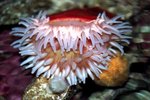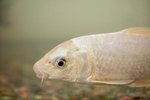Urochordata is one of three Chordata subphylum. Sometimes referred to Tunicata or sea squirts, these animals have a simple body structure and are abundant in deep water. Most of these creatures have two siphons on their body: one for sucking in food and water and another for releasing waste and water. However, colonial sea squirts share a siphon for waste removal. Despite their body simplicity, several diverse species exist in this subphylum.
Sea Pork
Sea Pork (Aplidium stellatum) is a type of sea squirt found along the eastern coast of North America and into the Gulf of Mexico. They attach to rock jetties or even floating docks to form colonies. The colonies can be up to 1 inch thick and over a foot long. While some people may assume its common name comes from the creamy pink color or texture of its tunic, the outer skin which provides support and protection to the creature, it does not. Instead, the name refers to the whitish appearance of the sea squirt after death, which resembles salted pork.
Golden Star Tunicate
The Golden Star Tunicate (Botryllus schlosseri) is another colonial urochordata species. These sea squirts are not native to North America but were introduced here and in other parts of the world from Europe. Colonies form on hard surfaces and contain thousands of individual tunicates. These individuals (called zooids) arrange themselves into star shapes. All zooids in a single colony are the same color but they can come in a wide range of colors, including red, orange, white, and green. Because each golden star tunicate is tiny -- less than 1/4 inch in length -- colonies diameters are usually no bigger than 4 inches.
Sea Peach
The Sea Peach (Halocynthia pyriformis) is a type of sea squirt that does not form colonies but can be found with others of its species. Unlike colonial tunicates, this species is larger: they can be as tall as 4 inches. Most specimens are orange or red, and some are striped. The tops of their two siphons have four corners making them more quadratic than circular as in other sea squirts. Specimens can be found throughout the North Atlantic.
Ciona Intestinalis
Ciona intestinalis may lack a common name, but this solitary sea squirt is abundant in the waters around Britain and Ireland. These creatures frequently attach to man-made surfaces, including concrete, and appear frequently in marinas and harbors. Each specimen can reach almost 6 inches in length and appears translucent with tinges of green and yellow. Because of this translucence, the sea squirt's internal organs are visible.
References
- West Virginia University: Phylum Chordata
- Animal Diversity Web: Urochordata
- University of California Museum of Paleontology: Introduction to Urochordata
- Smithsonian Marine Station at Fort Pierce: Aplidium stellatum
- Smithsonian Marine Station at Fort Pierce: Botryllus schlosseri
- Penzance: Squirts
- The Marine Flora & Fauna of Norway: Sea Peach
- The Marine Life Information Network: Ciona Intestinalis
Writer Bio
Amy Jorgensen has ghostwritten more than 100 articles and books on raising and training animals. She is also an amateur dog trainer. She has also written more than 200 blog posts, articles, and ebooks on wedding and party planning on behalf of professionals in the field.





